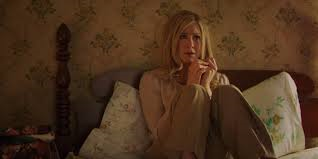
Jennifer Aniston and Tim Robbins are husband and wife in Life of Crime, Daniel Schechter’s adaptation of the Elmore Leonard novel Switch.
A pair of incompetent – but likeable – cons (John Hawkes and Mos Def) kidnap her and demand $1M in ransom. Her husband’s not paying, so she joins forces with the abductors to wreak a little vengeance.
Part black comedy, satire, melodrama, and seventies time capsule, filmmaker Daniel Schechter went the extra mile to serve Leonard’s story including convincing Aniston to go “dark” and locating a chilling collection of Nazi memorabilia.

There’s quite a collection of Nazi regalia in the kidnap house, which is rather startling. How did you find the stuff?
We found a collector in Michigan who had a lot of valuable and disturbing memorabilia, historically curated. I wanted to see it with my own eyes.
There were photos and medals and uniforms and grenades. There was such rich detail in that room. It was so distasteful, absolutely, but also it was cinematically preserved and it was a pleasure putting it in the film.
There’s something timelessly powerful about the Nazi sign. It stirs emotions with the bold colour and shape. The first thing we see is the flag draped over the Nazi symbol.
Jennifer Aniston – another gift to shooting this film – had to walk through the Nazi room then she could actually respond to this horrific collection of swastikas and be terrified of her abductor who was an anti-Semite. It was the first time she saw it.

The house is claustrophobic and creepy and somehow larger than life. There ‘s a sense of it being a living thing.
The house was the greatest location find I’ve ever seen. The house had to be appropriate and available and the person willing to let us in.
The house had to be big enough to house production and crew and within the zone of New York. The X-factors of that house were miraculous – little things like the set dressing, the wallpaper and tiles and fixtures had so much character.
There was something interesting around every other corner in the house. It suited us very well.
The character lived with his mother who had passed away so there were oddly feminine touches, perfume bottles, pink hairbrushes, peach sheets that you wouldn’t expect at first look but we wanted it to feel seventies with the sense of living within an older era.
There are many next cinematic touches and references and homages to other films – its fun.
The movie was cinematically playful not just a book reinterpreted on film. There are interesting camera moves, peeping eye holes. It was a fun movie to play around, like the rear view mirror shot.
There is playful wickedness, not genuinely ominous but it puts a smile on your face and reminds you of the old films you saw. I like to have fun with it and use inventive angles. I’m very invested in how its shot and the camera moves and in making it as visually exciting as possible.
Filmmakers haven’t really served Elmore Leonard well in the past.
To be clear there were three very good adaptations, Get Shorty, Out of Sight and Jackie Brown but there are certainly some that aren’t great. They haven’t pleased critics but Leonard Elmore’s work is unique.
You worked closely with him. What was that experience like for you as a fan and as a storyteller?
It was interesting to work with him because on one level he wanted to create an emotional distance because he wasn’t thrilled with past adaptations. But he’s a lover of films and he was invested in the outcome. It was a push-and-pull and I would do it again, if anyone would allow me to.